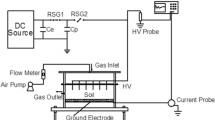Abstract
Polychlorinated biphenyls (PCBs) were removed by low-temperature plasma technique (dielectric barrier discharge) from heavily polluted soil and their intermediate products were analyzed. The removal rate ranged from 40.1 to 84.6% by different treatments, and they were also influenced significantly (P < 0.01) by soil particle-size, electric power, gas flow rate and reaction time. The optimal reaction conditions of PCB removal from the soil were obtained experimentally when soil particle-size, electrical power, flow rate and reaction time were 5–10 mm, 21 w, 120 mL·min−1 and 90 min, respectively. However, decreasing electrical power, flow rate and reaction time to 18 w, 60 mL·min−1 and 60 min respectively were also acceptable in view of the cost of remediation. This technique was characterized by the additional advantage of thorough oxidation of PCBs in the soil, with no formation of intermediate products after reaction. The technique therefore shows some promise for application in the remediation of soils contaminated with persistent organic pollutants in brown field sites in urban areas.
Similar content being viewed by others
References
Dimou K N, Su T L, Hires R I, Miskewitz R. Distribution of polychlorinated biphenyls in the Newark Bay Estuary. Journal of Hazardous Materials, 2006, 136(1): 103–110
Harrad S J, Sewart A P, Alcock R, Boumphrey R, Burnett V, Duarte-Davidson R, Halsall C, Sanders G, Waterhouse K, Wild S R, Jones K C. Polychlorinated biphenyls (PCBs) in the British environment: sinks, sources and temporal trends. Environmental Pollution (Barking, Essex: 1987), 1994, 85(2): 131–146
Ma W L, Li Y F, Sun D Z, Qi H. Polycyclic aromatic hydrocarbons and polychlorinated biphenyls in topsoils of Harbin, China. Archives of Environmental Contamination and Toxicology, 2009, 57(4): 670–678
Meijer S N, Ockenden W A, Sweetman A, Breivik K, Grimalt J O, Jones K C. Global distribution and budget of PCBs and HCB in background surface soils: implications for sources and environmental processes. Environmental Science & Technology, 2003, 37(4): 667–672
Aresta M, Caramuscio P, De Stefano L, Pastore T. Solid state dehalogenation of PCBs in contaminated soil using NaBH4. Waste Management (New York, N.Y.), 2003, 23(4): 315–319
Fridman A A, Rusanov V D. Theoretical basis of non-equilibrium near atmospheric pressure plasma chemistry. Pure and Applied Chemistry, 1994, 66(6): 1267–1278
Sobacchi M G, Saveliev A V, Fridman A A, Gutsol A, Kennedy L A. Experimental Assessment of Non-Thermal Plasma Techniques for Removal of Paper Industry VOC Emissions. Proc. 15th Int. Symp. on Plasma Chemistry, 2001, 5(7): 3135–3140
Magureanu M, Mandache N B, Parvulescu V I, Subrahmanyam C, Renken A, Kiwi-Minsker L. Improved performance of non-thermal plasma reactor during decomposition of trichloroethylene: Optimization of the reactor geometry and introduction of catalytic electrode. Applied Catalysis B: Environmental, 2007, 74(3–4): 270–277
Luk Yanov V B, Eremeev A P, Nesmeyanov A N. Synthesis of oxygen-containing organic compounds in electric discharges. Russian Journal of Physical Chemistry, 1974, 48(4): 531–533
Zhou L M, Xue B, Kogelschatz U, Eliasson B. Partial oxidation of methane to methanol with oxygen or air in a non-equilibrium discharge plasma. Plasma Chemistry and Plasma Processing, 1998, 18(3): 375–393
Okazaki K, Kishida T, Ogawa K, Nozaki T. Direct conversion from methane to methanol for high efficiency energy system with energy regeneration. Energy Conversion and Management, 2002, 43(9–12): 1459–1468
Tonkyn R G, Barlow S E, Orlando T M. Destruction of carbon tetrachloride in a dielectric-barrier/packed-bed corona reactor. Journal of Applied Physics, 1996, 80(9): 4877–4886
Ding H X, Zhu AM, Yang X F, Li C H, Xu Y. Journal of Physics D: Applied Physics, 2005, 38(23): 4160–4167
Subrahmanyam C, Renken A, Kiwi M L. Novel catalytic nonthermal plasma reactor for the abatement of VOCs. Chemical Engineering Journal, 2007, 134(1–3): 78–83
Ogata A, Einaga H, Kabashima H, Futamura S, Kushiyama S, Kim H H. Effective combination of nonthermal plasma and catalysts for decomposition of benzene in air. Applied Catalysis B: Environmental, 2003, (46):87–95
Demidyuk V, Hill S L, Whitehead J C. Enhancement of the destruction of propane in a low-temperature plasma by the addition of unsaturated hydrocarbons: experiment and modeling. Journal of Physical Chemistry. A, 2008, 112(34): 7862–7867
Li J, Li J, Jin Y Q, Liang W J, Li Y L. Treatment of volatile organic compounds by nontherm al plasma technology. Techniques and Equipment for Environmental Pollution Control, 2006, 7(6): 101–105 (in Chinese)
Gao J, Luo Y M, Li Q B, Zhang H B, Wu L H, Song J, Qian W, Christie P, Chen S M. Distribution patterns of polychlorinated biphenyls in soils collected from Zhejiang province, east China. Environmental Geochemistry and Health, 2006, 28(1–2): 79–87
Xu L, Teng Y, Zhang X L, Wang J J, Li Z G, Liu W X, Luo Y M. Combined remediation of PCBs polluted soil by plant and microorganism in a field trial. China Environmental Science, 2008, 28(7): 646–650 (in Chinese)
Yang K H, Wang B W, Xu G H. Dielectric-barrier discharge plasma characteristics and its application in chemical engineering. Journal of Chemical Industry and Engineering (China), 2007, 58(7): 1609–1618 (in Chinese)
Lee H M, Chang M B. Destruction of VOCs via silent discharge plasmas. Chemical Engineering & Technology, 1998, 21(12): 987–989
Hou J, Pan X X, Li C M, Hou H Q. The degradation of tolueneby non-equilibrium plasma. Acta Scientiae Circumstantiae. 1999, 19(3): 274–275 (in Chinese)
Jiang J M, Hou J, Zheng G Y, Hou H Q. The decomposition of benzene and xylene under normal atmospheric pressure by dielectric-barrier discharge. China Environmental Science, 2001, 21(6): 531–534 (in Chinese)
Author information
Authors and Affiliations
Corresponding author
Rights and permissions
About this article
Cite this article
Li, X., Zhang, H., Luo, Y. et al. Remediation of soil heavily polluted with polychlorinated biphenyls using a low-temperature plasma technique. Front. Environ. Sci. Eng. 8, 277–283 (2014). https://doi.org/10.1007/s11783-013-0562-8
Received:
Accepted:
Published:
Issue Date:
DOI: https://doi.org/10.1007/s11783-013-0562-8




